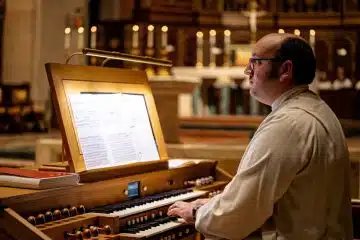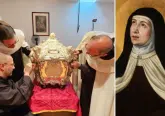Why does the Church honor Saints’ Relics
Question of Faith: Why does the Church honor saints’ relics? What is their history and purpose?
Reverencing saints’ bodies has a long tradition in the Church, from both regard for the human body and belief that the sacred can be mediated through the material. Scriptures share examples of Jesus’ power mediated through objects – such as the woman healed after touching the hem of His garment (Mt. 9:20-22). And in the Acts of the Apostles, people were even healed just by touching St. Paul’s clothing (Acts 19:11- 12).
CATACOMBS
In the first centuries of Christianity, believers distinguished themselves from the Roman Empire’s pagans by insisting upon burial (as opposed to cremation). Seeking a place to bury their dead, in Rome they interred the deceased on a few parcels of land owned by wealthy Christians, tunneling underground to maximize the number buried. Visits to graves became linked to prayers for (and to) the dead, especially when popes and martyrs were buried there. Christians prayed among their deceased relatives and friends’ remains, and even celebrated Mass there.
RELICS’ USE
This tradition of praying with the deceased developed as the Church began to honor certain men and women as members of the communion of saints and to reverence relics
– usually the saints’ bodies or objects connected with saints
– in churches and homes. As this practice grew, it was seen as essential for every altar on which Mass was celebrated to house a saint’s bodily relic. While no longer required in altars, the relic’s presence suggests the reality that when the Mass is celebrated, heaven and earth unite.
Eventually the Church distinguished between classes of relics, holding the saint’s actual body as most worthy of honor. These “first class” relics include flesh, bone, teeth, and hair. Also to be respected, lesser relics include the holy person’s belongings, most often clothing. Another relic class developed eventually, for an object touched to a first class relic.
Non-Catholics criticize the use of relics, seeing their reverence as superstition. Never worshipped, relics are a physical connection to a holy person, and so are honored or reverenced. Often found in churches and sometimes in homes (since the faithful are permitted to keep them), for most Catholics, relics are not a significant part of their spiritual lives.
AUTHENTICITY
In the Church’s early years, relics were distributed without a means of assuring their authenticity, resulting in the need for the Church to testify to their legitimacy. Though there undoubtedly were fakes, the Church guards against this. Relics are bound by string and a wax seal imprinted with the certifying official’s insignia and accompanied by an official document (with the same insignia) indicating the saint’s name and the class of relic. If the relic is separated from the document, it may not be publicly displayed.
The tradition of relics can be seen as unusual, perhaps even superstitious, but the reverence afforded the saints is ancient. As we honor these holy people and request their intercession, their remains remind us of what their lives represent, for we venerate the relics of the saints to adore better Him whose saints they are.
 Father David Endres is associate professor of Church history and historical theology at Mount St. Mary’s Seminary & School of Theology.
Father David Endres is associate professor of Church history and historical theology at Mount St. Mary’s Seminary & School of Theology.
This article appeared in the February 2022 edition of The Catholic Telegraph Magazine. For your complimentary subscription, click here.













